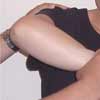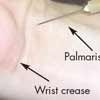Woman With Chronic Wrist Pain
A 38-year-old secretary has had right wrist pain for the past 6 months. It was initially relievedby ibuprofen but is now persistent and makes it difficult for her to type. The pain is worse atnight.

Figure 1
PATIENT PROFILE:
A 38-year-old secretary has had right wrist pain for the past 6 months. It was initially relieved by ibuprofen but is now persistent and makes it difficult for her to type. The pain is worse at night. She also notes some weakness when she grasps objects: she is unable to open jars or twist off lids, and she occasionally drops her coffee cup. During the past month, she has experienced periodic numbness and tingling in her right thumb and index finger. Otherwise, her health is excellent. She takes no medications other than the occasional ibuprofen.
WHICH TEST WOULD BE MOST HELPFUL IN MAKING THE DIAGNOSIS?
A. Hawkins test.
B. Finkelstein test.
C. Phalen test.
D. None of the above.
THE CONSULTANT'S CHOICE
This patient most likely has carpal tunnel syndrome, which is caused by compression of the median nerve in the carpal tunnel of the wrist. She has an occupation that requires prolonged or repeated wrist flexion and a characteristic history.

Figure 1

Figure 2
Patients with carpal tunnel syndrome usually complain of pain in the wrist and in the thenar area of the palm. The pain is aggravated by wrist flexion and extension and may radiate to the elbow. Numbness and tingling in the thenar area of the palm, in the thumb, and in the index and middle fingers are also usually present. Grasping objects may be difficult. Patients may wake at night with pain and numbness because the wrist falls into flexion during sleep.
The Phalen test (C) is diagnostic of carpal tunnel syndrome. To perform this test, ask the patient to flex both wrists for 30 seconds as shown in Figure 1; the wrist flexion need not be forced. A positive result reproduces the patient's symptoms. This woman experienced wrist pain and numbness and tingling in her thumb and index finger when the test was performed.
The Hawkins test (A) is used to diagnose rotator cuff impingement and tendinitis of the shoulder. In the Hawkins test, the patient flexes one shoulder forward to 90 degrees; the examiner then rotates the shoulder internally to evaluate for pain (Figure 2). This maneuver compresses the supraspinatus muscle against the surrounding structures. Pain on rotation constitutes a positive result. In this patient, the Hawkins test produced no pain.

Figure 3
The Finkelstein test is used to diagnose de Quervain tenosynovitis, an inflammation of the tendon sheaths of the abductor pollicis longus and the extensor pollicis brevis muscles of the thumb. To perform the test, have the patient hold the hand in ulnar deviation, with the thumb flexed and abducted into the palm and the fingers fully flexed (Figure 3). This maneuver places tension on the tendons and their sheaths and is painful if tenosynovitis is present. The Finkelstein test produced no pain in this patient.
WHERE ARE SYMPTOMS OF MEDIAN NERVE COMPRESSION MOST LIKELY TO BE FOUND?
A. The dorsal surface of the thumb.
B. The palmar surface of the little finger.
C. The dorsal surface of the middle finger.
D. The palmar surface of the index finger.
THE CONSULTANT'S CHOICE
The median nerve innervates the palmar surface of the index finger (D), thumb, middle finger, and half of the ring finger, along with the tips of the thumb, index finger, and middle finger-and half the tip of the ring finger. The dorsal surface of the thumb (A), except for the tip, is innervated by the radial nerve. The palmar surface of the little finger (B) is innervated by the ulnar nerve. The dorsal surface of the middle finger (C) is innervated by the radial nerve.
In a patient with suspected carpal tunnel syndrome, the physical examination focuses on assessment of the sensory and motor functions of the median nerve. First, observe the palms of both hands and compare the thenar area of the injured hand with that of the non-injured hand to check for atrophy. Although lack of atrophy does not rule out carpal tunnel syndrome, its presence indicates a more significant or long-standing problem.

Figure 4
Next, tap over the median nerve at the wrist flexion crease (on the ulnar side of the palmaris longus tendon) (Figure 4). If the tapping produces tingling on the palmar surface of the thumb, index finger, and middle finger (Tinel sign), carpal tunnel syndrome is likely.
Finally, test the strength of the thenar muscles by assessing the ability of the thumb to move toward the little finger against resistance. Weakness may be detected in patients with carpal tunnel syndrome and can result in the dropping of objects, such as cups and glasses.
Additional studies are not needed unless the diagnosis is in doubt. Studies that might be ordered include:
- Electromyography.
- Nerve conduction studies.
- Plain radiographs of the wrist.
- MRI.
Plain radiographs are indicated when bone pathology is suspected. Electromyography and nerve conduction studies can confirm the loss of function in the median nerve but have negative results in 20% of patients with clinically proven carpal tunnel syndrome. MRI is reserved for ruling out rare conditions, such as anomalous muscle bellies and nerve tumors.
WHICH OF THESE IS NOT A FIRST-LINE TREATMENT FOR CARPAL TUNNEL SYNDROME?
A. Corticosteroid injection.
B. Activity modification.
C. Wrist splints.
D. NSAIDs.
THE CONSULTANT'S CHOICE
Carpal tunnel syndrome responds to conservative measures in most patients. Conservative measures are especially recommended for patients who are pregnant; carpal tunnel syndrome sometimes develops during pregnancy, but it usually responds to conservative therapy-and typically terminates postpartum.
The first step in the treatment of this disorder is to identify the activity that is causing the problem and find ways to minimize it (B). For a secretary, workstation modifications to decrease wrist flexion and extension (eg, adjusting keyboard height, providing wrist and forearm supports) can be beneficial. Taking a break from typing every few hours helps decrease fatigue. To help a patient obtain the cooperation of superiors in making changes, write a note to his or her employer explaining how the changes will increase productivity.
If no contraindication exists, a short course (7 to 10 days) of an NSAID (D) or corticosteroid is beneficial.
Wrist splints (C) to limit flexion and extension are a mainstay of treatment. The splint should be worn at night and, if needed, during the day. Patients are sometimes reluctant to use the splint during the day because it interferes with work performance or because they do not want to call attention to the problem.

Figure 4
Injections with 1 mL of local anesthetic and 1 mL of a long-acting corticosteroid (A) can benefit patients who do not respond to conservative measures. Flex the wrist and have the patient flex the fingers; identify the wrist flexion crease and the palmaris longus tendon. Insert the needle on the ulnar side of the palmaris longus tendon about 1 cm proximal to the wrist crease (Figure 4). Have the patient extend the fingers to bring the needle into the carpal tunnel, and slowly inject 1 to 2 mL of the corticosteroid/anesthetic solution.
If you have difficulty in locating the palmaris longus tendon, use the patient's ring finger to direct the needle in the following manner:
- With the patient's fingers fully flexed, advance the needle at a 45-degree angle for about 1 cm until you feel resistance.
- Have the patient move the ring finger; if this results in movement of the needle, it is appropriately located.
Surgery is indicated when all the above measures are unsuccessful.
Outcome of this case. The patient was initially treated with workstation modifications, NSAIDs, and a splint for 4 weeks. Her symptoms markedly diminished but then recurred after the splint was removed. The carpal tunnel was then injected with a corticosteroid and lidocaine solution, and 4 more weeks of splinting at night were prescribed. This resulted in a complete remission of symptoms. The patient continues to do well.
References:
FOR MORE INFORMATION:
- Goodyear-Smith F, Arroll B. What can family physicians offer patients with carpal tunnel syndrome other than surgery? A systematic review of nonsurgical management. Ann Fam Med. 2004;2:267-273.
- Shahady EJ. Primary Care of Musculoskeletal Problems in the Outpatient Setting. New York: Springer-Verlag; 2006.